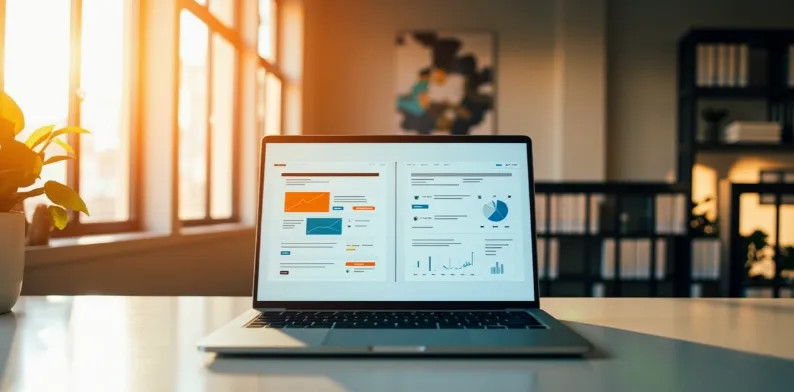
SEO, or Search Engine Optimization, is about making your website more visible on search engines like Google. But it’s not just about tricks to rank higher. It’s about balancing what search engines want with what your users need.
Understanding SEO Basics

SEO involves optimizing your website to rank higher in search engine results pages (SERPs) for relevant keywords. This brings more organic (free) traffic to your site. But SEO isn’t just about search engines—it’s also about creating a website that users love. A balanced SEO strategy ensures your site is both discoverable and enjoyable, leading to better rankings and more engaged visitors.
Balancing User Experience and Search Engine Optimization
The core of balancing SEO is ensuring your website is both user-friendly and search engine-friendly. Here’s how:
- For Users: Your site should be easy to navigate, load quickly, and provide valuable, engaging content. Users want answers to their questions without frustration.
- For Search Engines: Your site needs to be crawlable, with proper use of keywords, meta tags, and structured data. This helps search engines understand and index your content.
This balance is crucial because search engines like Google prioritize websites that offer a great user experience. If your site is hard to use or slow, it won’t rank well, no matter how many keywords you include. For example, a site with great content but poor mobile optimization might lose rankings due to Google’s mobile-first indexing.

Keyword Research and Optimization
Keywords are the terms people use to search for information. Balancing keyword usage means finding the right terms and using them naturally. Here’s how to do it:
- Conduct Thorough Research: Use tools like Google Keyword Planner or SEMrush to find keywords with good search volume and low competition. Focus on long-tail keywords, like “how to balance SEO for small businesses,” which are specific and less competitive.
- Incorporate Keywords Naturally: Place keywords in your content, titles, and meta descriptions without overstuffing. Aim for a keyword density of 1-2% (one mention per 100 words) to keep it natural.
- Match User Intent: Ensure your content aligns with what users are searching for. For example, if someone searches “SEO tips,” they likely want actionable advice, not a history of SEO.
Overusing keywords can make your content feel robotic and lead to penalties from search engines. Write for humans first, and search engines second.
Technical SEO
Technical SEO involves the behind-the-scenes work that makes your site accessible to search engines. Key areas include:
- Site Speed: A fast-loading site keeps users happy and improves rankings. Use Google PageSpeed Insights to check and improve speed. Compress images, minimize code, and enable browser caching.
- Mobile-Friendliness: With Google’s mobile-first indexing, your site must work well on mobile devices. Test your site with Google’s Mobile-Friendly Test.
- Crawlability: Ensure search engines can easily crawl your site. Use a clear URL structure (e.g., hqlinkers.com/blog/seo-tips) and submit a sitemap via Google Search Console.
Technical issues, like broken links or unindexed pages, can prevent your site from ranking. Regularly audit your site to catch and fix these problems.
On-Page vs Off-Page SEO
SEO has two main components: on-page and off-page. Balancing them is essential for success.
- On-Page SEO: This includes optimizing individual pages with:
- Relevant keywords in titles, headings, and content.
- Clear meta descriptions that summarize the page.
- Internal links to guide users to related content, like our Keyword Research Guide.
- Proper use of headings (H1, H2, H3) for structure.
- Off-Page SEO: This involves building your site’s authority through:
- High-quality backlinks from reputable sites, like Forbes.
- Social media engagement to drive traffic and brand awareness.
- Guest posts on relevant blogs, such as those listed in our Guest Posting Sites.
Focusing only on on-page SEO leaves your site without authority, while focusing only on off-page SEO might mean your content isn’t optimized. Both are needed for a strong strategy.
Link Building
Backlinks are like votes of confidence from other websites. They signal to search engines that your site is trustworthy. Focus on:
- Quality Over Quantity: Earn links from high-authority, relevant sites, like industry blogs or news outlets. Use Moz’s Domain Authority Checker to evaluate potential linking partners.
- Natural Link Building: Create valuable content that others want to link to, like in-depth guides or unique data. Avoid buying links, as this can lead to penalties.
For example, a guest post on a reputable site can earn a backlink while exposing your brand to a new audience. Check our Guest Posting Sites for ideas.
Local SEO (If Applicable)
For businesses with physical locations, local SEO is crucial. It helps you rank for searches like “best coffee shop near me.” Key steps include:
- Optimize Google My Business: Ensure your profile has accurate details, like address, hours, and photos.
- Get Local Citations: List your business in directories like Yelp or local chambers of commerce.
- Encourage Reviews: Ask customers to leave reviews on Google or Yelp. Respond professionally to all reviews, even negative ones.
Local SEO drives foot traffic and builds trust with nearby customers. If your business isn’t location-based, you can skip this step.
Staying Updated with Algorithm Changes
Search engines like Google frequently update their algorithms, affecting how sites rank. Recent updates emphasize user experience, mobile optimization, and content quality. To stay ahead:
- Follow trusted SEO blogs, like Moz or Search Engine Journal.
- Monitor your site’s performance with Google Search Console.
- Adjust your strategy based on new guidelines, like Google’s focus on helpful content.
Staying informed ensures your SEO efforts remain effective despite algorithm changes.
Image Suggestion: Place a screenshot here of the Google Search Console dashboard, highlighting metrics like impressions, clicks, and position. Ensure the image is clear and labeled.
Signs of an Imbalanced SEO Strategy
If your SEO isn’t balanced, you might notice:
- Low rankings for targeted keywords.
- High bounce rates (users leaving quickly).
- Poor mobile performance.
- Inconsistent organic traffic.
- Few or no backlinks from reputable sites.
Regularly check your site’s performance to catch these issues early. Tools like Google Analytics can help.
Tools to Help You Balance SEO
Here are some tools to streamline your SEO efforts:
| Tool | Purpose | Link |
|---|---|---|
| Google Keyword Planner | Find relevant keywords with search volume data | Keyword Planner |
| Google Search Console | Monitor site performance and indexing issues | Search Console |
| Google PageSpeed Insights | Check and improve site speed | PageSpeed Insights |
| Moz Domain Authority Checker | Evaluate backlink quality | Domain Analysis |
| SEMrush | Conduct keyword and competitor research | SEMrush |
These tools help you track progress and make data-driven decisions.
Final Thoughts
SEO is an ongoing process, not a one-time task. Start with the basics: research keywords, optimize your site technically, and create valuable content. Then, build authority through backlinks and stay updated on algorithm changes. Don’t get discouraged if results take time—consistent effort pays off. By balancing user needs with search engine requirements, your website can rank well and provide real value to your audience. Keep learning, stay adaptable, and always prioritize your users.



